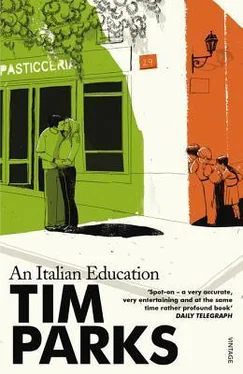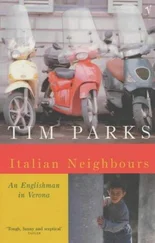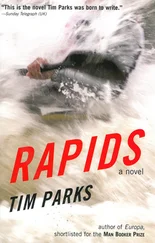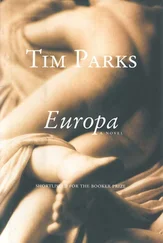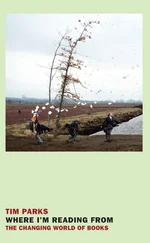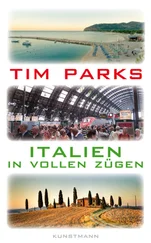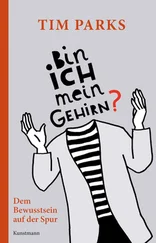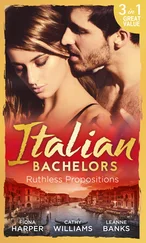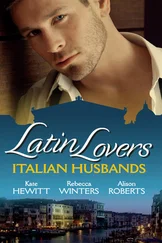People laugh, though there is just a little nervousness, suggesting that such things are closer to the bone here than, say, jokes about the Irish in London. And what am I to do? Do I give her a lecture on the return trip about how southerners are just as much human beings as anybody else? Or should I say that you can tell jokes like that for fun, but not in public, in case people take them the wrong way. After all, little Pasquale’s parents are southerners…
‘Listen, Stefi,’ I begin when I’ve got her on her own for a minute on the return trip — there aren’t as many of us now because, after letting the kids play for an hour, many mothers felt they would be too tired for the walk back, and so have departed with fathers and tupperware and wine bottles in the cars — ‘Listen, you do know what terrone means, don’t you?’
‘Of course,’ she says, ‘someone who comes from the south.’
‘And…’
But she interrupts: ‘Papà, is Nonno a terrone ? Francesca Piva says my nonno is a terrone if he comes from Pescara. I’ll be furious with him if he’s a terrone .’
Foolishly, instead of pointing out how ridiculous it is for her to change her opinion of her caro nonno according to where he comes from, I get involved in a technical discussion of where exactly people begin to be called terroni . Much further south than Pescara, I point out. Pescara isn’t considered the south at all. Then realising that one only validates this kind of prejudice by caring about its exact geography, I say, ‘Anyway, if Nonno is a terrone that just shows that they are as nice as anyone else, doesn’t it, and that there’s no reason to dislike them or start tossing them out of train windows.’
‘He never keeps his promises,’ she says grimly. ‘He was supposed to come at Easter and he didn’t. You can’t deny that.’
Just as one can never deny that people did laugh at her joke.
We return by a different path, snaking steeply down the hill to Mizzole. There are kilometres of young vines planted here, with black plastic stretching in lines across their roots to keep in the moisture. Knowledgeably, Stefano tells me that there have never been vines before on this hill. The wine will be awful. It’s just tax write-offs and EC subsidies. Sai com’è? Same with the sunflowers they’ve started growing at the bottom. Who ever saw sunflowers in the Val Squaranto before?
Further down the valley the fortunately eternal cherry trees are on the point of blossoming. All the little cavalrymen, Maestra Elena tells the children, are waiting to get out and wave their swords. From across the valley come the regular explosions of clay-pigeon shooting, an incomprehensible sport, but always better than hunting for sparrows and blackbirds. One of the little girls has collected a small bagful of cartridges in six different colours. Apparently, she likes to make decorations with them at home. Marta is afraid of lead poisoning.
D’Artagnan and All-three-musketeers find an early lizard with one leg missing and there is the usual discussion about whether to put the thing out of its misery or not. Whereas, if D’Artagnan ever comes across a vipera , of course, it will be mercilessly hacked to bits with sharp stick and penknife. Occasionaly the hero pokes in the leaves by the side of the path, but finds no more than primroses and periwinkles and long discarded Coke cans.
In Mizzole we stop in the square, for an ice cream. This square is just thirty metres by thirty of cheap paving, but there’s a bar the other side of the road which has its tables under big white sunshades on the piazza. The proprietor looks carefully up and down the dusty road before crossing with a tray of drinks.
The children eat their ice creams. For entertainment there’s an old field gun anchored in cement by a miserable war memorial of grey concrete, black railings and artificial carnations. One of the fathers shows the kids how to winch up the barrel of the gun, how to aim it. Stefano remarks to me that he managed to avoid military service thanks to the only-son-of-widowed-mother rule. Marta says she hopes conscription will be abolished by the time Beppe gets there. Michele, Rita says, will no doubt enjoy his military service, and most likely Stefi would, too, if she got the chance. She’s now arguing furiously for a chance to sit on the barrel. Maestra Elena tries to get the children away from the gun to talk for a moment about the war memorial, but there are only seven children left now, at once tired and rowdy, and the monument is short on information: MIZZOLE, AL SUOI CADUTI, it says: to her fallen soldiers. The list of names beneath gives no indication of which war they died in. D’Artagnan hits the top of the monument with his catapult and I have to confiscate it.
When the adults sit to have coffee, Maestra Elena pulls out a pack of cigarettes. She’s an efficient-looking woman in her early forties with a couple of children of her own and just the right mixture of kindness and discipline, earnestness and fun. She puffs. Immediately, two of the children start singing one of those indoctrinating songs the school is full of these days:
Papà non fumare
Papà non fumare
Perchè il fumo ti fa tanto male
Daddy don’t smoke
Daddy don’t smoke
Because smoke is so bad for you
The song goes on and on jollily rhyming pipes and cigars with the miseries of cancer and heart disease. But Maestra Elena, who may well have been responsible at some point for teaching them this stuff, only smiles. ‘It doesn’t do them any harm,’ she says, ‘to know that teacher has a vice or two.’ How different from the South Tyrol!
The last stop is Mizzole’s famous shrine with the tree growing out of it. There’s a tall, dry-stone wall at the end of the village with a tiny chapel built into it, no more than two metres by two. It has a miniature dome on top and is open at the front with just a low wall and black gate to defend it. Through the middle of that wall, obscuring an altar and statue behind, explodes a gnarled and stunted ash tree, and through its branches you can just read: SANT’EUROSIA — VERGINE E. M.
Michele asks me what ‘E. M.’ means. I don’t know. Nervous about seeming ignorant, I ask Rita in a low voice. She explains, ‘e martire’ — and martyr. So why didn’t they write it, Michele asks. Because they ran out of space. And Rita says vergine gets written in full because it’s more important than being a martyr. In the end it goes without saying that a saint is a martyr, though none of those present knows exactly what Sant’ Eurosia did to get herself martyred…
The gate beside the tree has a latch but no lock, so all the children immediately crowd through into the tiny space where a life-size white statue stands on the altar, head in the dome. One of the girls reads from a typed information sheet under cracked perspex on the altar. She has that monotonous reading voice children have, the others interrupting, Maestra Elena correcting. But still we learn nothing of Sant’Eurosia, only that her image was first brought here by Spanish soldiers in the sixteenth century, that the villagers erected this statue to her and planted the ash tree in 1630 in the belief it would protect them from the plague, and then that ‘This miracle came true, for no one in Mizzole died of the plague.’ Later, reads the little girl, in ‘an undetermined period’, the ash tree died. The villagers decided to remove it. But when they came to cut it next morning, it had miraculously sprouted.
The present shrine, however, is as recent as 1947. ‘When the townsfolk were evacuated here from Verona to avoid bombing, they made a vow that if the saint saved all of them they would build a handsome chapel around the old capitello . Once again the miracle came true.’
Читать дальше
